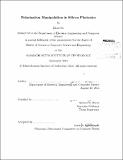Polarization manipulation in silicon photonics
Author(s)
Su, Zhan, Ph. D. Massachusetts Institute of Technology
DownloadFull printable version (20.43Mb)
Other Contributors
Massachusetts Institute of Technology. Department of Electrical Engineering and Computer Science.
Advisor
Michael R. Watts.
Terms of use
Metadata
Show full item recordAbstract
Silicon photonics is moving fast toward industrialization. It satisfies the increasing demand for higher speed, larger bandwidth communication. Thus it has a wide range of applications including high-performance computing, data center, telecom etc.. However, the on-chip (waveguide) and off-chip (fiber) components for silicon photonics have quite different characteristics for the polarizations of light. The polarization dependence of on-chip silicon photonics components still remains a bottleneck for the real application of it. Efficient devices for manipulating polarizations are highly demanded. Herein, we present the designs of adiabatic polarization rotator (PR) and polarization splitter and rotator (PSR) to deal with this issue. With their adiabatic nature, larger bandwidth (>100 nm) and better fabrication tolerance have been achieved. Besides, the effort toward the realization of a full-functional two-input two-output PBS, which is an exact correspondent of the traditional cube PBS in free space is presented. The structure was fabricated in a commercial state-of-art CMOS foundry and has a bandwidth of over 150 nm and less than -10dB crosstalk level. Though its application in traditional communication can be replaced by PS, PR or PSR, its application in more accurate systems such as polarization-entangled states generation and manipulation in quantum optics or on-chip heterodyne interferometers. Moreover, original compact-ring resonator based even-dropping optical bus system is proposed and analyzed in detail. Large free-spectral range offered by small radius micro-ring gives more communication channels to fully utilize the power of wavelength division multiplexing (WDM). Furthermore, a multi-channel WDM broadcasting system is proposed using the optical bus design. We have demonstrated a two-channel broadcasting system, which can be further increased to more than 16 channels.
Description
Thesis (S.M.)--Massachusetts Institute of Technology, Dept. of Electrical Engineering and Computer Science, 2013. Cataloged from PDF version of thesis. Includes bibliographical references (pages 137-142).
Date issued
2013Department
Massachusetts Institute of Technology. Department of Electrical Engineering and Computer SciencePublisher
Massachusetts Institute of Technology
Keywords
Electrical Engineering and Computer Science.